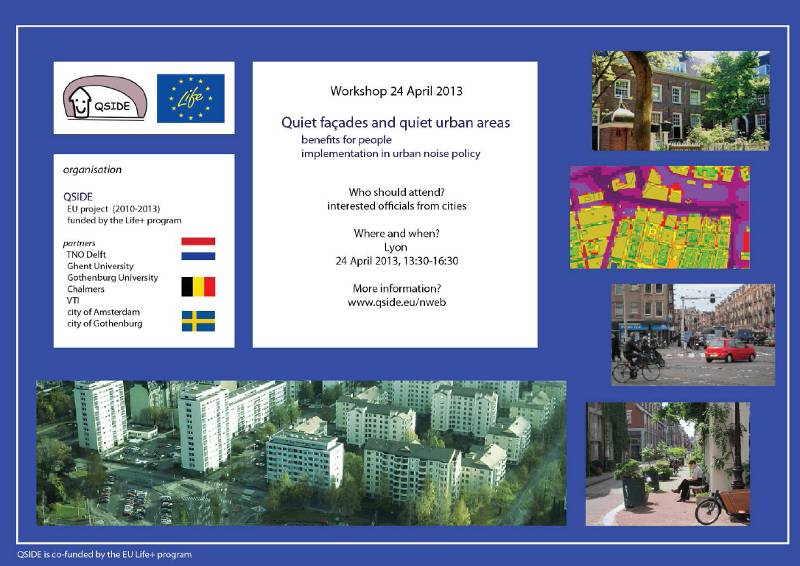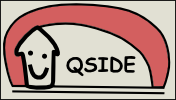
Progress
Short progress report for QSIDE.
Workshop for EU cities 2013
24 April 2013, Lyon, organized by VTI and TNO
The invitation for the QSIDE workshop is shown below. The invitation was sent to a large number of potential attendants, including about 60 partners of the working group Noise of the Eurocities network, and to about 40 other relevant persons. In addition the invitation was sent to representatives of five French cities near Lyon: Grenoble, Saint-Etienne, Nice, Montpellier, and Aix-en-Provence. The QSIDE workshop preceded a meeting of the working group Noise of Eurocities (25-26 April). The idea was that in this way we would attract more participants. However, the number of participants was a bit disappointing, possibly because of limited financial resources of cities in this period of financial crisis.
The total number of persons attending the workshop was 13. Three cities were represented at the workshop: Berlin, The Hague, and Lyon. In addition the QSIDE partners Amsterdam and Gothenburg were present. Further, three partners of the related European projects HARMONICA, HUSH, and QUADMAP attended the workshop. This gave us the opportunity to have valuable discussions on the relations between the three projects and QSIDE. The program of the workshop was as follows.
- Presentation of QSIDE - by Erik Salomons, Frits van den Berg, Carlo Schoonebeek, Martin Knape, and Mikael Ögren
- Presentation of HARMONICA - by Vincent Gissinger
- Presentation of HUSH and QUADMAP - by Francesco Borchi
- Discussions.
Since the group was small, discussions were held during the presentations rather than at the end of the workshop. The presentation of QSIDE followed the structure of the QSIDE website www.qside.se. The HARMONICA project was presented by Vincent Gissinger of Acoucite Lyon. The HUSH and HARMONICA projects were presented by Francesco Borchi of the University of Florence. The sheets of the presentations are reproduced in the appendices of the Action 6 report.
Invitation to QSide workshop (click to load PDF)

Consortium meeting 2013
31 Jan - 1 Feb 2013, Amsterdam, organized by AMS and TNO.
This was the final QSIDE consortium meeting. Discussions were held on the finalization of the QSIDE Actions. The approach for the workshop in Lyon was discussed.
Consortium meeting 2012
A QSIDE consortium meeting was organized in Prague, on 14 June, just after the Euronoise meeting. Discussions were held on various topics, in particular on values of limit noise levels for quiet facades and quiet areas (see below). The next meeting will be on 1 Feb 2013, in Amsterdam.
Conference papers (dissemination)
QSIDE results have been described in seven conference papers in 2012, three at the Euronoise conference and four at the Internoise conference. Abstracts of these papers can be found on the documents page.
Action 2
On 28 September 2012 the Action 2 report about the QSIDE acoustic model was completed. It was agreed that updates of this report will be prepared later. The model is an extension of common engineering models used for noise mapping. The extension is represented by sound level contribution, which is to be added to the level calculated with the noise-mapping model. Analytical formulae have been derived for the background level, including contributions for the canyon effect, intermediate canyons, and turbulent scattering. Aspects of 2D and 3D have also been studied.
Action 3
On 28 September 2012 the Action 3 report about the QSIDE human response model was completed. It was agreed that updates of this report will be prepared later. Analyses of quiet-side benefits and quiet-area benefits have been performed of five population studies/surveys:
- a cross-sectional survey in Stockholm and Gothenburg,
- an intervention study in Gothenburg,
- a cross-sectional survey in Flanders,
- a focused study in Ghent,
- a cross-sectional study in Amsterdam.
Interpretation of the results is still ongoing. In some cases clear quiet-side benefits are found, in other cases the benefit is less clear.
Action 4
In action 4, noise maps and sound levels have been prepared of the cities/regions studied in 3. One of the objectives of action 4 is to demonstrate how noise levels in cities change for various scenarios. Scenarios are related to urban planning and building block design. An article (with QSIDE acknowledgement) about these demonstrations has been published in 2012 in the scientific journal Landscape and Urban Planning (volume 108, pages 2-16). The article demonstrates how closed building blocks lead to lower noise levels at quiet facades than open building blocks do.
Action 5
The work performed in action 1 has provided a good starting point for action 5. Information about current practice in twelve European cities about quiet sides and quiet areas has been collected. Various noise levels for (legal) definition of quiet facades and quiet areas are employed. In general, these levels are higher than what would be desirable from the viewpoint of preventing harmful effects of traffic noise. Currently, in QSIDE the idea is explored to recommend a range of levels rather than a single limit levels for quiet facade/area, ranging from a low level (ideal) to a higher level (more practical). At the 2011 meeting in Gothenburg, ideas in the consortium have been discussed to consider noise abatement in the broader framework of sustainable urban development. Indeed, traffic measures have an impact not only on noise annoyance, but on many other aspects of a city (air pollution, safety, mobility). For example, promoting a modal shift from car to bicycle reduces traffic noise but also enhances public health through physical activity. Another reason for taking a broader view is that the attractiveness of quiet areas in cities depends not only on noise levels but also on other qualities of the areas, such as vegetation or nice buildings. Presently the action 5 team members are working on the website/document with EU recommendations. The website will contain not only text, but also pictures (and possibly videos) showing good and bad examples of quiet facades and quiet areas.


